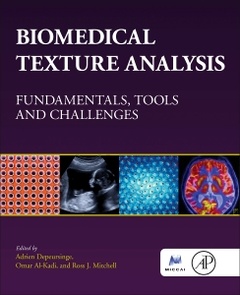Description
Biomedical Texture Analysis
Fundamentals, Tools and Challenges
The MICCAI Society book Series
Coordinators: Depeursinge Adrien, S Al-Kadi Omar, Mitchell J.Ross
Language: English
Subject for Biomedical Texture Analysis:
Support: Print on demand
Description
/li>Contents
/li>Readership
/li>Biography
/li>Comment
/li>
Biomedical Texture Analysis: Fundamentals, Applications, Tools and Challenges describes the fundamentals and applications of biomedical texture analysis (BTA) for precision medicine. It defines what biomedical textures (BTs) are and why they require specific image analysis design approaches when compared to more classical computer vision applications.
The fundamental properties of BTs are given to highlight key aspects of texture operator design, providing a foundation for biomedical engineers to build the next generation of biomedical texture operators. Examples of novel texture operators are described and their ability to characterize BTs are demonstrated in a variety of applications in radiology and digital histopathology. Recent open-source software frameworks which enable the extraction, exploration and analysis of 2D and 3D texture-based imaging biomarkers are also presented.
This book provides a thorough background on texture analysis for graduate students and biomedical engineers from both industry and academia who have basic image processing knowledge. Medical doctors and biologists with no background in image processing will also find available methods and software tools for analyzing textures in medical images.
1. Fundamentals of Texture Processing for Biomedical Image Analysis2. Multi-Scale and Multi-Directional Biomedical Texture Analysis3. Biomedical Texture Operators and Aggregation Functions4. Deep Learning in Texture Analysis and its Application to Tissue Image Classification5. Fractals for Biomedical Texture Analysis6. Handling of Feature Space Complexity for Texture Analysis in Medical Images7. Rigid Motion Invariant Classification of 3D Textures8. An Introduction to Radiomics: An Evolving Cornerstone of Precision Medicine9. Deep Learning Techniques on Texture Analysis of Chest and Breast Images10. Analysis of Histopathology Images11. MaZda - a Framework for Biomedical Image Texture Analysis and Data Exploration12. QuantImage - An Online Tool for High-Throughput 3D Radiomics Feature Extraction in PET-CT13. Web-Based Tools for Exploring the Potential of Quantitative Imaging Biomarkers in Radiology
Omar S Al-Kadi received the PhD in Biomedical Engineering from the University of Sussex (Brighton, UK) in 2010, and the MSc. and BSc. in Information Technology and Biomedical Engineering from the University of Canberra (Canberra, Australia) and Cairo University (Cairo, Egypt) in 2003 and 2001, respectively. In 2010 he joined King Abdullah II School for Information Technology at the University of Jordan (Amman, Jordan) as an Assistant Professor, and in 2011 he was a Visiting Researcher in the Center for Vision, Speech and Signal Processing at the University of Surrey (Guildford, UK). During the period from 2013 to 2015 he was a Research Fellow at the Institute of Biomedical Engineering at the University of Oxford (Oxford, UK), working on improving 3D Ultrasound-based drug delivery strategies for liver tumor analysis and segmentation. He was also a Visiting Professor at the Medical Image Processing lab within the Institute of BioEngineering at the Swiss Federal Institute of
- Defines biomedical texture precisely and describe how it is different from general texture information considered in computer vision
- Defines the general problem to translate 2D and 3D texture patterns from biomedical images to visually and biologically relevant measurements
- Describes, using intuitive concepts, how the most popular biomedical texture analysis approaches (e.g., gray-level matrices, fractals, wavelets, deep convolutional neural networks) work, what they have in common, and how they are different
- Identifies the strengths, weaknesses, and current challenges of existing methods including both handcrafted and learned representations, as well as deep learning. The goal is to establish foundations for building the next generation of biomedical texture operators
- Showcases applications where biomedical texture analysis has succeeded and failed
- Provides details on existing, freely available texture analysis software, helping experts in medicine or biology develop and test precise research hypothesis




